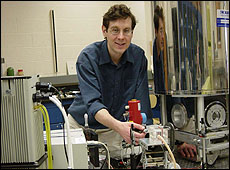Archives
UB physicist uses NSF award to study "strange metals"
By ELLEN GOLDBAUM
Contributing Editor
John Cerne, assistant professor in the Department of Physics, College of Arts and Sciences, has received a prestigious National Science Foundation (NSF) CAREER award to probe the fundamental behavior of "strange metals," including materials related to high-temperature superconductors, as well as magnetic semiconductors.

Physicist John Cerne has received a
prestigious National Science Foundation award to probe the fundamental
behavior of "strange metals."
PHOTO: PATRICIA MEIDER
Under the CAREER award, Cerne will receive a total of $500,000 over five years.
The CAREER program, according to the NSF, recognizes and supports the early career-development activities of teacher-scholars "who are most likely to become the academic leaders of the 21st century."
Under the grant, Cerne will study metals that are "strongly correlated systems" in which there are strong correlations, or interactions, among electrons.
Cerne explained that those correlations are responsible for extraordinary effects, such as high-temperature superconductivity, that have never been seen in conventional materials.
While electrons in conventional metals contribute to the current individually, he said it is much more challenging to understand what is happening in strongly correlated materials.
"For example, it's been almost 20 years since high-temperature superconductors were discovered and there still is no consensus on what's carrying the current in them," he said.
He noted that a better understanding of such effects may allow physicists eventually to take advantage of their extraordinary properties, developing faster, more efficient, more versatile electronic materials, such as those that are both semiconducting and magnetic so that they not only store information, but process it as well.
"Traditionally, condensed-matter physicists didn't have to worry about these correlations between electrons," Cerne said. "But these interesting new effects cannot be understood in terms of single electrons. So trying to understand these correlations is the next natural step in physics. We're in unknown territory."
Cerne studies the interaction between infrared light and matter in magnetic fields to examine novel effects in these materials and to probe their dynamic properties as a function of wavelength.
"With these infrared techniques, we have a better chance to reveal their intrinsic behavior, to test theoretical models and to perhaps discover a few surprises along the way," said Cerne.
As part of the educational component of the NSF CAREER award, Cerne is developing an instructional Web site geared toward high school students and beginning undergraduates to depict more graphically and interactively some of the more difficult concepts in physics associated with waves and light.
